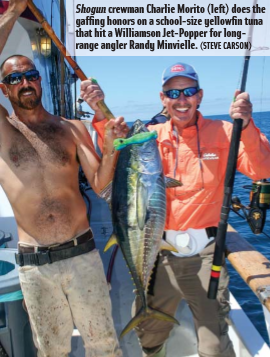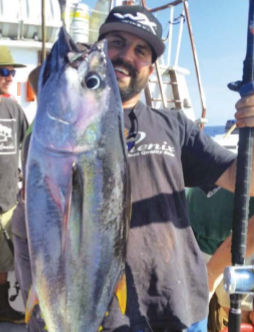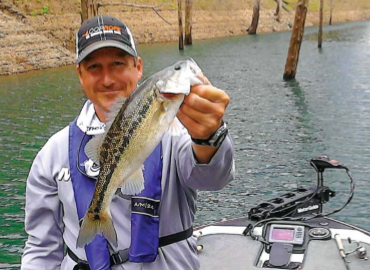GEARING UP FOR TROUT
WHAT EASTERN SIERRA ANGLERS NEED FOR A TRIP TO THE MOUNTAINS
By Mike Stevens
With a quarter-century worth of Eastern Sierra outings in my rearview mirror, you can imagine the adjustments, fine-tuning, fat trimming and experimenting that has gone on in terms of how I gear up to fish for trout up Highway 395. In reality, 25 years is nothing compared to how long many other Sierra troutheads have been fishing up there, and they certainly have their own arsenal specific to
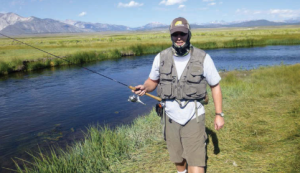
their trouting needs, but with trout opener 2015 beckoning this month, I hope that sharing how I do it can eliminate the learning curve for those new to fishing the area, and maybe even turn a seasoned veteran on to a trick of mine.
RODS AND REELS
When it comes down to it, everything begins with your quiver of rods and reels. For the most part, ultralight rods are the way to go, but rod length is something that has evolved over the course of my Sierra tenure. When I started, I had a little 5-footer that I liked to use on creeks because it was easy to get through sticks and climb down rocks with, and then I had a 6-foot ultralight that I used in lakes for a little more casting distance.
These days, a 6-footer is the shortest rod I use, and while it might be slightly more cumbersome while bushwhacking around creeks, I like to reach out as far as I can when my lure swings downstream and ultimately, across the current.
With a longer rod, it’s easier to maintain that angle and keep the lure in the strike zone for a few more key seconds. It also allows you to reach out and fish undercuts on the bank that you are on without having to get too close to the water. On lakes, I will use that same rod to cast heavier lures like spoons, minnow baits and heavier spinners, because I get all the casting distance I need out of it.
That setup is paired with 4-pound test line – the heaviest line I use for most Sierra applications – because it’s going to get nicked and hung up often in the creeks, and you won’t snap off a big lure on a long cast on a lake with it like you will with lighter mono.
I also have a 7½-foot rod that I use for smaller lures and lighter line. I fish a lot of plastics like trout jigs and plastic trout worms with only 1/16-ounce of weight aiding my cast, if not less. When the long rod is paired with 2-pound test, I can fire those light lures as far as I ever need to. It is also the perfect setup for a fly-and bubble rig. Admittedly, you don’t see many rods this long anywhere, and a 7- or even 6½-footer would get the job done pretty well, too.
As for reels, I never put a lot of analysis into picking them, and I think it is silly to spend a ton of money on a trout reel (or rod for that matter). I just look for a smooth drag, no wobble when reeled, and a bail that flips from open to closed without much effort. Currently, my 4-pound-test reel is a Shimano Sedona 500, which runs about $75, but my main 4-pound reel is an Okuma Avenger 15, a very well-performing reel priced under 40 bucks. Both of my rods are Daiwa Pressos ($75). There are a lot of great ones out there at a good price – just don’t convince yourself you need to break the bank on trout gear.
LURES
You can cover most fishing bases with spoons, spinners, minnow baits and plastics, and that likely isn’t groundbreaking news to you. But I have found that having a variety of tried-and-true “confidence” models is the way to go, rather than simply my favorite of each.
In my first decade of Sierra fishing, I threw the obligatory black/gold Panther Martin 90 percent of the time because it was proven, and I 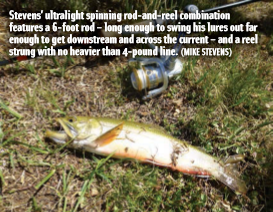 had confidence in it. It was to the point where, in my head, if I didn’t get bit on it, there must not be fish there and I would move on. Boy, was I wrong.
had confidence in it. It was to the point where, in my head, if I didn’t get bit on it, there must not be fish there and I would move on. Boy, was I wrong.
On one trip, I decided to try as many different lures as I could. What I found to be the case quite often was a situation in which I would pick a historically good spot, and start getting fish on the third, fourth or even fifth lure I threw.
And we aren’t talking a fluke fish just to keep the skunk off; we’re talking from dead to five trout in 20 minutes. This approach went on for years, and here are the specific lures that I have kept in my “starting rotation” after another decade (and counting ) of experimentation:
For spoons, I go with Thomas Buoyants, Colorados and Cyclones, Kastmasters, and Luhr-Jensen Hot Shots. I know, no breaking news there, but I have drilled it down quite a bit beyond that. For Buoyants, don’t get tunnel vision for gold/ red because everyone else is fishing them and they appear in the most reports. I have had the most luck on watermelon, with plenty more on frog, brown trout and copper. Fish them slow and anytime you want to use metal in shallow or weedy water, because they are easy to swim high
in the water column. And if you only try one thing I mention here, throw them in the Owens River. I hate spoons in creeks, but for whatever reason they work in the “O.”
Colorado and Cyclone (also from Thomas) spoons are in my box, mainly because I know everyone is Buoyant-crazed and the fish aren’t seeing nearly as many of these. Kastmasters are the best in the wind, and I also like to step outside the color box with them and go with fringe colors like gold/fluorescent green, copper (it’s hard to find) and rainbow trout. The 1/16-ounce model can be a lifesaver on that long rod with 2-pound line in the backcountry when the bite slows mid-day. But you can still get brookies on long casts to the middle. I feel like a Hot Shot is kind of a happy medium between a Buoyant and a Kastmaster, and again, not used as much as other classic Sierra trout lures, so I use it just to get a different look out there.
As for plastics, there are a bunch of different brands out there that have worked very well for me, but I have settled on Sierra Slammers (sierraslammers.com) for one reason: the colors are chosen specifically for the region (if not for certain lakes – the South Lake Special, anyone?) as the company is owned by Jared Smith, general manager of Parcher’s Resort on Bishop Creek and the author of Fishin’ Trails.
For jigs, carry a few natural colors like grasshopper and cricket, plus some loud ones like orange/ red, white/yellow and green/black. I rarely use plastic trout worms solo, but I do like to use them as trailers on my jigs, and I like the one that’s just a natural worm color, or adding an orange one to any color jig. Sierra Slammers also makes a line of trout swimbaits, which are a blast to fish and have a track record of fooling big fish.
I carry a variety of floating and sinking Rapalas in classic styles, as well as some of the newer models like Husky Jerks and Scatter Raps. Owner Cultivas are another proven crankbait for trout, and new to the list are Berkley Flicker Shads that have great action, come in an awesome array of colors, and are a bargain at $3.99 each. I use minnow baits in the Owens, creeks, lakes with big browns like Crowley and Convict, and in the fall for “brown bagging” purposes in the lakes up there and Rush Creek.
As for spinners, I don’t use them nearly as much as I used to, but this is where I really keep it simple. Rooster Tails in natural colors is home for me. Salmonfly, grasshopper, brown, black and green are all in the mix, and can be fished on any type of water up there.
ACCESSORIES
This is where I have a lot of fun, so it might be best if I just rattle off some nuggets just to get it all in. First of all, retire the tackle box, or at least quit carrying it around with you; it just slows you down. Vests, chest packs, lumbar packs, leg pockets and backpacks are the way to go. I use these items in various combinations depending on what kind of fishing I am doing at that moment. If it’s a quick run to drive-up lakes after dinner, I might just bring my Tenzing lumbar pack, or just a box of lures in my leg pocket. If I am heading into the backcountry all day long, and I need food, water, maybe a jacket, it’s a combination of the lumbar pack and the backpack. Whatever it is, don’t carry it; wear it.
Polarized sunglasses are game- changers, and it only takes a day of wearing them on the water to be convinced, and this is one thing that you should purchase the best you can afford. On the high end, Maui Jim and Costa shades can’t be beaten. For the best bang-for-your-buck, look at anything from Smith Optics with a Chroma Pop lens, and if you want to keep it under $100, Zeal Optics and Hobie have great options. But even cheapies will convince you of the power of polarization.
Those Buff-type facemask things don’t only make you look like some kind of cool fishing ninja in your photos, they are also very functional. While they are mainly used as a physical barrier from the sun, I use one when it gets buggy and I don’t want to inhale a flock of mosquitos, or to soak and wear it around my head or neck when it’s
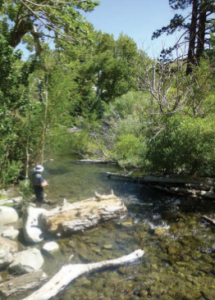
hot.
Two-way radios are also a big part of my attack, as I am usually up there with three other guys who all take off in their own direction once we reach the water. They are ideal for a “divide and conquer” approach to finding fish. Also we make calls along the lines of: “I’m going up the trail to try the lake;” “Let’s get out of here, meet me at the truck;” and “I think this bear is going to bite me.” It’s all a lot easier with radios.
You can find them by the pair from reputable brands like Motorola, Midland and Cobra for under $40, and up toward $100 for models with better range or ones that are waterproof.
I saved my favorite item for last, because it is so simple yet crazily efficient, and I love it. That would be my beloved big Rubbermaid container. Yes, the same one you put your Christmas decorations in. I stock it with my lumbar pack, backpack, vest, boots, walkie-talkies, tackle, net, raingear, trail food – basically any gear but the rods. It is tastefully covered with trout-related and local business stickers.
In the tent, RV or condo, the lid serves as the perfect work bench (with a raised edge that keeps things from rolling off) for prepping gear under a lantern. So when I arrive at base camp, all I need to do is bring in my duffel bag full of clothes, and that container, and when I get back home, it easily slides on to a shelf in the garage until it’s summoned for another trip, or for impromptu “grab-and-go” duty. CS

